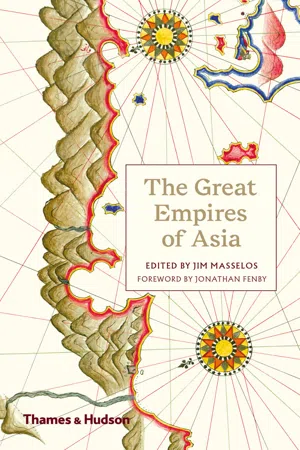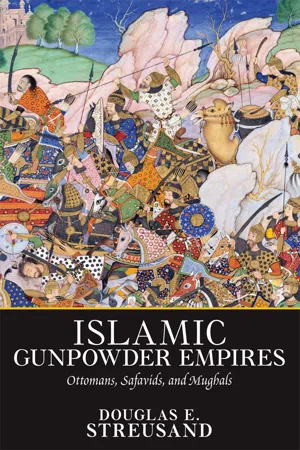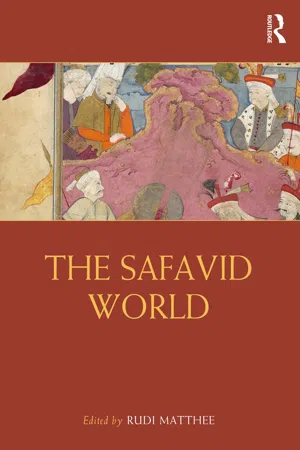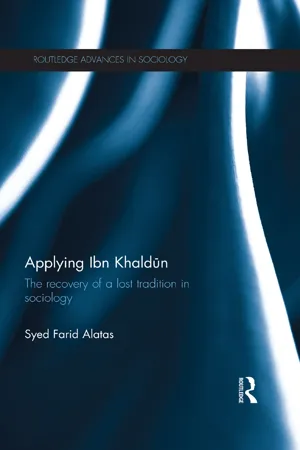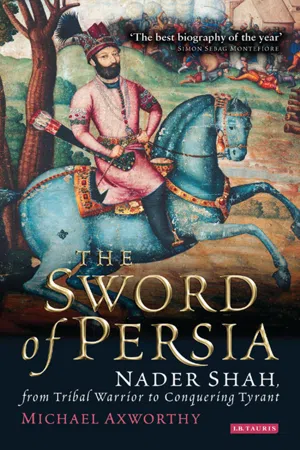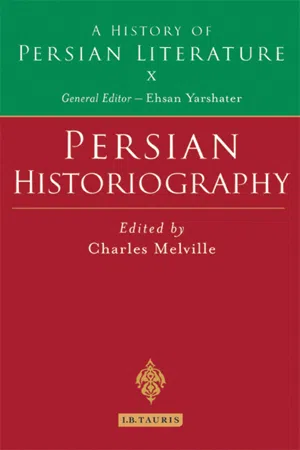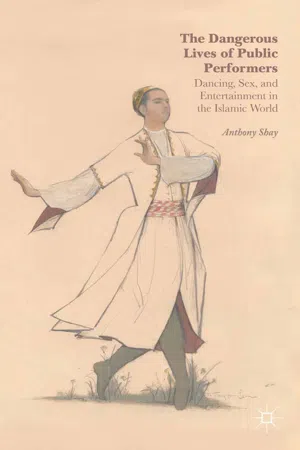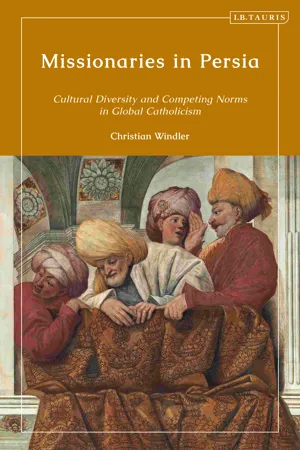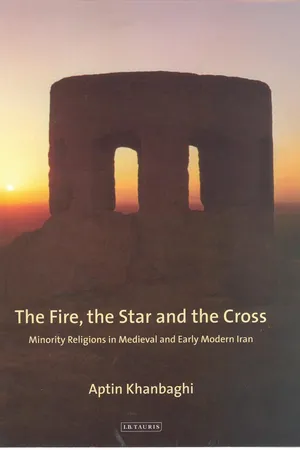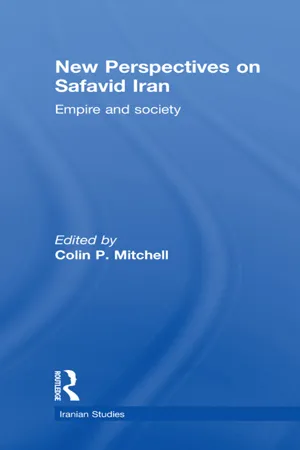History
Safavid Empire
The Safavid Empire was a Persian dynasty that ruled Iran from 1501 to 1736. It is known for its promotion of Twelver Shia Islam as the state religion and for its significant cultural and artistic achievements, including the development of Persian literature, art, and architecture. The empire also engaged in conflicts with the neighboring Ottoman Empire and Mughal Empire.
Written by Perlego with AI-assistance
Related key terms
12 Key excerpts on "Safavid Empire"
- eBook - ePub
- Jim Masselos, Jonathan Fenby(Authors)
- 2018(Publication Date)
- Thames and Hudson Ltd(Publisher)
CHAPTER FIVE Persia: The Safavids 1501–1722 SUSSAN BABAIE T he Safavid Empire of 1501–1722 was the longest-lasting Persian polity in the history of Islamic Iran. Its alignment of ancient Persian ideas of kingship with Imami Shia doctrines of Islam created a distinctive culture whose powerful legacy can be traced in the later history of the region. 1 The Safavid Empire grew out of a messianic venture in the north west of Persia, which became the anchor for the reemergence of a distinctly Persian empire not seen since the advent of Islam in the 7th century. Imami or Twelver Shiism (named for the twelve Shia imams) became the dominant religion, although Sunni Islam was prominent along with large communities, native or imported, of Zoroastrians, Jews and Christians. The territorial gains and losses of the Safavid period settled to an area more or less contiguous with the political boundaries of modern Iran. The Persian and Shia cultural identity of the Safavid Empire grew out of continual conflict or competition with neighbouring Sunni empires – the Ottomans, the Mughals and the Uzbeks – and political alliances and trade partnerships with Europe and Asia. A cultural synthesis, forged out of the ethnic, linguistic and religious groupings in Safavid society, revived the political concept of Iran, rooted in its long history, as a proto-nationalist phenomenon. 2 The Boy Becomes King ‘The padshah [king] of the inhabited quarter of the globe’ 3 was the fourteen-year-old Ismail (1487–1524), the charismatic young leader of the Safaviyye order. This was one of the numerous Sufi (mystical) orders that arose in western Asia in the wake of the Mongol invasions of the early 13th century. The order was founded by Sheikh Safi al-Din Eshaq (1252–1334) and centred on a shrine complex at Ardabil, near the south-western shore of the Caspian Sea. Leadership of the order was inherited; Ismail was a direct descendant of Sheikh Safi (a ‘Safavid’) - eBook - ePub
Islamic Gunpowder Empires
Ottomans, Safavids, and Mughals
- Douglas E. Streusand(Author)
- 2018(Publication Date)
- Routledge(Publisher)
Chapter 4 The Safavid EmpireT he Safavid Empire never equaled the size, power, or wealth of the Ottoman or Mughal empires. Its history had a different pattern. It did not grow steadily over many decades but reached its maximum size within a few years of its foundation and maintained those boundaries only briefly. Safavid rule transformed the religious life of the empire but had a much less significant effect on its ethnic composition and social structure. Some historians have questioned whether it qualifies as an empire at all, though the Ottomans and Mughals had no difficulty identifying the Safavids as peers. The Safavid polity began as a confederation of Turkmen tribes, led not by the leader of one tribe but by a Sufi shaykh , Ismail Safavi (I use the anglicized Safavid for the order and dynasty but Safavi in personal names). The Safavid ideology—a blend of ghuluww , Turko-Mongol conceptions of kingship, and the folk Sufism of the Turkmen—energized the tribes. This ideology and Ismail’s consistent military success from 1501 to 1512 suspended the normal political operation of the tribal confederation. After the first Safavid defeats, at Ghujduvan in 1512 and Chaldiran in 1514, Ismail’s loss of prestige altered the balance of power within the confederation, giving the tribal leaders decisive authority and making their struggle for dominance the central issue in Safavid politics. After 1530, Ismail’s son, Shah Tahmasp, gradually strengthened his position enough to manipulate, rather than be manipulated by, the tribes. After his death, however, the tribal chiefs again dominated the empire until the time of Abbas I (1588–1629). Abbas transformed the Safavid polity from a tribal confederation into a bureaucratic empire. The primacy of the bureaucracy, with the tribes present but peripheral, survived until the rapid collapse of the empire in 1722.Map 4.1 Safavid EmpireThe Ottoman and Mughal empires clearly deserve the title agrarian. They represented transplants of the agrarian bureaucratic traditions of the Middle East to rich agrarian regions elsewhere. The Safavids had no such advantage; the tribal resurgence in the eighteenth century showed that the ecology of the Iranian plateau continued to favor pastoral nomadism. The Safavid regime relied not on broad agricultural prosperity or control of major trade networks but on the export of a single commodity: Abbas I’s central army and central bureaucracy depended on income from the export of silk. The Safavid polity thus became a gunpowder empire because of the increase in global trade in the sixteenth century. Otherwise, the Safavid Empire, in all probability, would have remained a tribal confederation, held only the central and western parts of the Iranian plateau, and had a shorter lifespan. The income from this commerce did not, however, permit a return to the previous agrarian pattern of Abbasid times, based on massive irrigation works. The empire thus became a peculiar hybrid. Under Abbas I, the center became strong enough to reduce the Qizilbash tribes to political insignificance but could not eliminate them. There was no open frontier to divert them to. When the central regime failed, the tribal forces became dominant by default. - eBook - ePub
- Rudi Matthee, Rudi Matthee(Authors)
- 2021(Publication Date)
- Routledge(Publisher)
5Figure 28.2 Isfahan. ‘Shāh Tahmāsb and Homāyun’, mural from the audience hall of the Chehel Sotun Palace. Photograph by M. SarrafThe Safavids, with their empire located at the center of Muslim Asia, were the only dynasty to share borders with all three of the other Turkic empires of the time, the Ottomans, Uzbeks, and Timurids. This geographic setting enabled them to offer protection to many a fallen prince from neighboring Muslim realms. This unique ‘foreign policy’ achievement of the Safavids had significant consequences, especially in the Safavid relations with the Mughal Empire. In the pre-secular world, bodily submission and oath-making between vassal and king were serious acts that, once performed, were very difficult to undo. This is why such moments were commemorated in art and memorialized in dynastic chronicles and diplomatic correspondence. Princes of rival dynasties seeking Safavid protection and largesse were not only a major point of pride for the dynasty, but also allowed them, in theory, to claim sovereignty over their neighboring empires. While they were seldom able to act on these claims, the Safavids nevertheless used their status as the granters of princely asylum as a major source of symbolic capital.Another element of Safavid ‘international’ cultural prestige was their control over the premier urban centers of artistic, literary, and philosophical production of the post-Mongol era, namely Tabriz, Herat, Shiraz, and Isfahan. The courtly and intellectual trends produced in these cities were avidly consumed in the much wealthier climes of India. Even more significant was the fact that Safavid territories contained the ancestral shrines of Islam’s sacred lineages – Alid and Sufi – which attracted large numbers of Muslim pilgrims from India and elsewhere. Thus, without ever setting foot in India, the Safavid dynasty exerted a great influence on Muslim India’s political and cultural imagination. This observation holds true for northern and central India, which came under Mughal suzerainty by the third quarter of the sixteenth century, as well as for the Deccan peninsula in the south (Deccan literally means ‘the south’), which remained in the hands of a number of different Muslim and Hindu dynasties until the Mughal conquests of the region in the second half of the seventeenth century. Nevertheless, the Safavids did not achieve all of this on their own. Rather, they inherited their cultural edge from the patterns set by their Timurid and Aqqoyunlu predecessors in Iran, Khorasan, and Transoxiana. Any inquiry into Safavid place in South Asian political imagination must begin with a consideration of this historical background. - eBook - ePub
Applying Ibn Khaldūn
The Recovery of a Lost Tradition in Sociology
- Syed Farid Alatas(Author)
- 2014(Publication Date)
- Routledge(Publisher)
qizilbāsh owed allegiance. Unsuccessful in Anatolia and on the defensive, Ismā‘īl and his followers retreated to Iran and established the Safavid state in 907/1501. By 909/1503 he had control over Azerbaijan, western Iran and the Tigris-Euphrates basin.The account by Savory, generally accepted as the standard narrative, begins with the story of the emergence of the Safavid sufiorder in Ardabīl in eastern Azerbaijan in north-western Iran, and its emergence into a movement and its founding of a state. The Safavids rose to power on the basis of a dynamic ideology. The main components of this ideology were that (1) the Safavid shahs were “the shadows of God upon earth” (ẓill Allāh fī al-arḍ ); (2) they were also the representative of the Mahdī, the twelfth Imam of the Ithnā ‘Asharī Shi‘ah; and (3) they were the perfect spiritual directors (sing. murshid-i kāmil ) of the Ṣafaviyya order.4 The Safavid family claimed descent from the the seventh Imam, Mūsā al-Kāẓim (d. 183 AH/799 AD). The most important ancestor of the Safavid shahs was Shaykh Ṣafī al-Dīn (b. 1252/53), founder of the order of the Ṣafaviyya.5 Shaykh Ṣafī was succeeded as spiritual head of the order by his son, Ṣadr al-Dīn Mūsā (1304/05–91/92). During his time the order spread among the tribes of eastern Anatolia and Syria, particularly among the pastoral Turcoman nomads.6 It was also during Shaykh Ṣadr al-Dīn’s time that the Ilkhanid Empire in Iran disintegrated and gave way to numerous Turcoman and Persian principalities. The Chubadin amir in Azerbaijan, Mālik Ashraf, had Shaykh Ṣadr al-Dīn imprisoned in Tabriz, probably out of fear of the growing influence of the Ṣafaviyyih order which was turning into a political movement.7 Many members of the order fled north and found refuge with the Jānī Beg Maḥmūd, a descendant of Chingiz Khan and the ruler of the western Qipchāq (1340–57).8 - eBook - ePub
Sword of Persia
Nader Shah, from Tribal Warrior to Conquering Tyrant
- Michael Axworthy(Author)
- 2010(Publication Date)
- I.B. Tauris(Publisher)
Within a few years they took the rest of western Persia, and Fars and Khorasan, but were prevented from breaking back into their old homelands in Anatolia when an Ottoman army defeated Esmail at the battle of Chaldiran in 1514. This failure limited the new regime to borders corresponding closely to those of ancient Persia. The rivalry between the Ottoman and Safavid Empires was given extra bitterness by the Sunni/Shi‘a religious schism. Before the Safavid conquest the Persian territories were little more disposed to Shi‘ism than any other part of the Islamic world, apart from centres of strong Shi‘a belief like the shrine cities of Qom and Mashhad. Sunni Muslims were probably in a majority; and outside Persia there were large numbers of Shi‘as in Anatolia, the Lebanon and elsewhere. But once the Safavids and their Qezelbash followers were established in Persia, they pursued a religious policy that was to turn the country into a predominantly Shi‘a State. The Safavids imported Shi‘a scholars from the Lebanon and Arabia, and enforced Shi‘a religious practice in mosques and schools. Sunni theologians left Persia for more favourable lands. At the same time Shi‘as were persecuted in the Ottoman territories, where they were regarded as traitors and potentially as spies for the Qezelbash enemy. To understand Persia in the early eighteenth century it is necessary to understand the Shi‘ism that underpinned the Safavid State. The origins of the division within Islam go back to the era of the Prophet himself. Shi‘a Muslims believe that Mohammad chose his cousin Ali as his successor. * But despite this, others were elected as caliph or temporal leader after the Prophet’s death in AD 632: in succession, Abu Bakr, Omar, and Osman ibn Affan, the last of whom was assassinated in 656. These first three caliphs were occupied with wars of conquest, and the administration of newly conquered territories, but Ali held himself aloof, devoting himself to a life of prayer and preaching - eBook - ePub
Persian Historiography
A History of Persian Literature
- Charles Melville, Charles Melville(Authors)
- 2012(Publication Date)
- I.B. Tauris(Publisher)
53By the time Shah Abbâs came to power, the Safavids had been in control of Iran for nearly a century. Shah Abbâs initially faced numerous challenges to his rule, including a very powerful group of Qezelbâsh who had reasserted their power before he came to the throne. Once Abbâs consolidated his rule, however, the Safavids became a major force on the international scene, engaging in war and diplomacy with neighboring Ottomans, Mughals, and Uzbeks. At the same time, various European powers had established trading companies in Iran. Eventually, as the dynasty gradually began to appear more secure and unlikely to collapse, its historiography appears to have become less reliant on the pre-Safavid past. It had a well-established history, which had already undergone numerous revisions during the reigns of earlier Safavid kings, in particular Shah Tahmâsp. There was thus enough Safavid history to justify a lengthy volume devoted to the reigns of the Safavid kings alone. Some, such as Shah Tahmâsp, ruled for so long that it became to compile a substantial book solely on his reign.54 Furthermore, pretensions to universal rule were less effective in an Islamic world divided into Ottoman, Mughal, and Safavid Empires. Newer Safavid legitimizing ideas, primarily based on principles of Twelver Shi’ism, become consolidated and gradually replaced Chengisid and Timurid notions of universal rulers.55 Safavid historiography reflects this shift, explaining why Eskandar Beg, imitating Amini, included an account of Mohammad and the Twelve Imams but omitted the rest of pre-Safavid Islamic history.Thus, as time passed, an increasing number of works were dynastic rather than the general/universal histories of the earlier period. Of the major chronicles composed during Shah Abbâs’s reign we may consider only one, Qâzi Ahmad Qomi’s Kholâsat-al-tavârikh, a general history, even though the pre-Safavid portions of this work have not survived. It is perhaps significant that this was the first chronicle written during Shah Abbâs’s reign: Qâzi Ahmad was keenly aware that he was the first individual to have undertaken history writing in a long time, and this may explain why his text reflects earlier styles of Safavid historiography, and seeks to put Abbâs’s reign once more in the larger context, as a reassertion of Safavid power after a prolonged period of disorder.56 However, a similar perception is found in Jonâbadi’s Rowzat-al-safaviyye, covering the 127 years from the accession of Shah Esmâ’il, which the author claims was the first historical work to be written since the time of the death of Qazâq Khan Takkalu (in 1565), relying for his knowledge of subsequent reigns on what he had heard from reliable witnesses and seen for himself.57 Of the rest, Natanzi’s Noqâvat-al-âthâr and Monajjem Yazdi’s Târikh-e Abbâsi cover the reigns of Shah Abbâs and his two immediate predecessors (the latter only briefly). Siyâqi Nezâm’s Fotuhât-e homâyun was conceived as a history of the first twelve years of Shah Abbâs’s reign, although only one portion of the chronicle has survived. Eskandar Beg’s Âlam-ârâ-ye Abbâsi is a fully-fledged dynastic history with a short account of Mohammad and the Imams. Similarly, Fazli Beg Khuzâni’s Afzal-al-tavârikh is a dynastic history beginning with Safavid origins through the reign of Shah Abbâs, though some parts have not survived (or were never completed).58 - eBook - ePub
The Dangerous Lives of Public Performers
Dancing, Sex, and Entertainment in the Islamic World
- A. Shay(Author)
- 2014(Publication Date)
- Palgrave Macmillan(Publisher)
In order to put perspective on the importance of the so-called gunpowder empires that were established after the destruction and ravages inflicted by the Mongols and Turks, I turn to the observations of historian Charles H. Parker. “Traditionally, historians have presented the 1400s and 1500s as the ‘age of discovery,’ when Europeans began to explore, encounter, and exploit territories in Asia, Africa, and America” (2010, 1). But, such a view, still very prevalent in academia, is to diminish the cultural and economic influences of the Ottomans, Safavids, and Mughals who founded long-lived dynasties to rival and even outperform, economically and militarily, those of Europe during that period. European travelers described in tones of awe the splendor of these empires. “The Safavid Empire in Iran, the Mughal Empire in India, and the Ottoman Empire in Anatolia, all created large territorial empires and developed strong state systems that fostered trade, promoted the spread of the Islamic faith, and allowed the diffusion of Asian culture into the wider world” (52). Thus, taking Parker’s more global perspective in which to frame the three empires that I analyze in this chapter will enable me to demonstrate the cultural richness that these empires displayed in the arts, and their stunning architectural legacy, such as the Taj Mahal or the core buildings of Isfahan and Istanbul, in particular, still impresses the viewer.The power, achievements, and lasting impacts of the Ottoman, Safavid, and Mughal empires make the impasse of post-Abbasid politics hard to recall. All three empires won a degree of durable legitimacy no Muslim dynasty had attained since the Abbasids and maintained large and coherent polities for longer than any other Muslim dynasty, including the Umayyads and Abbasids. Their endurance and coherence permitted them to have enduring impacts on society and culture and on political patterns that have lasted until the present. (Streusand 2011, 291) - eBook - ePub
Missionaries in Persia
Cultural Diversity and Competing Norms in Global Catholicism
- Christian Windler(Author)
- 2024(Publication Date)
- I.B. Tauris(Publisher)
2 In the Shadow of the Shah: The Safavid Empire as an Arena for Catholic MissionIn the sixteenth century, contacts between Europeans and Persians were few and far between. Europeans showed little interest in the region. What information was available was fragmentary and chiefly secondhand. European observers combined this small store of empirical information with the knowledge about ancient Persia that they had inherited from the Greeks and the Romans. Few Europeans traveled from India to the fort on Hormuz, which had been in Portuguese hands since the early sixteenth century, and onward into the Persian Gulf and the heartland of the Safavid Empire. Portuguese interests focused mainly on the coastal towns on the Persian Gulf, as is evident from the surviving written accounts and maps. The envoys the Portuguese governors of Hormuz and the viceroys of the Estado da Índia sent to the Safavid court beginning in 1514 received little attention in Persia. Contacts with other Christian courts remained episodes at best.1This situation of mutual indifference ended around 1600. News of the successes of ʿAbbās I’s troops against the Ottomans that were reaching the European courts fostered projects of an alliance with the shah. A variety of European expectations came to focus on the Safavid Empire. At the court of Philip III, king of Castile and Portugal, and at the Roman Curia, hopes arose of realizing a twofold dream: military victory over the Turks, the enemies par excellence of Christendom, and the conversion to Christianity of large numbers of Muslims.2 Around the same time, from the Indian Ocean, the English and Dutch discovered the Safavid Empire as a potential trading partner.On the Persian side, Shah ʿAbbās I (r. 1588–1629) was similarly searching for allies against the Ottomans. Moreover, his politics of empire-building created the structural conditions needed to enhance and solidify contacts with European courts and trading companies, as well as to attract Catholic missionaries. Indeed, Shah ʿAbbās I consolidated monarchical rule over a vast socioculturally and religiously heterogeneous empire, not only by expanding bureaucratic institutions and a mercenary army but also by integrating the various population groups into the court networks. - eBook - ePub
A History of Social Justice and Political Power in the Middle East
The Circle of Justice From Mesopotamia to Globalization
- Linda T. Darling(Author)
- 2013(Publication Date)
- Routledge(Publisher)
41Fifteenth-century sultans used the concepts of the Circle of Justice to justify their administrative centralization, creating social order and protecting the poor. Elites claimed lands and positions of power as their just rewards for service to the ruler. Peasants and townsmen demanded fair taxation and social order in the name of justice. Rebels fought against sultanic oppression and official corruption. The proper functioning of the Circle was a goal that concerned groups throughout Ottoman society.War, cultural exchange, and the Safavids (1501–1722)
In the years around 1500, while the Ottoman Empire grew territorially and institutionally, Safavid Iran (1501–1722) emerged from a union of the Akkoyunlu dynasty with a Shi‘i Sufi order north of Tabriz, the Safavi order.42 Over the sixteenth century, the Safavid Empire expanded and centralized, developing a gunpowder army on the Ottoman model, expanding its commerce, and developing religion’s role in its ideology.43 The Ottomans under Bayezid II (1481–1512) expanded their navy and gained control of the eastern Mediterranean. Bayezid’s successor Selim I (1512–20) defeated the Safavids (1514) and Mamluks (1516–17), acquiring most of the Arab lands and western Iran. Athough they fought the Safavids, however, the Ottomans continued to appreciate and employ Persian cultural products.Bayezid II and Persian culture
Bayezid II came to the throne with a promise to reverse Mehmed II’s divisive taxation policies, since Mehmed’s amassing of new resources for military expansion had aroused strong opposition. Besides taking uncultivated or unawarded land to bestow as timars on ordinary soldiers or his slave troops, he confiscated lands from private owners and pious foundations and re-awarded them as timars to make their holders provide military service.44 Although this policy expanded the ruler’s opportunity to provide justice to taxpaying peasants, it was seen as injustice to the powerful, particularly the prominent Turkish warrior families and Sufi foundations enriched by lands from the early conquests. The elites reacted by bringing Mehmed’s son Bayezid to the throne and forcing him to return confiscated lands, eliminate military demands on religious foundations and private property owners, and raise money by levying extraordinary taxes on the common people.45 - eBook - ePub
The Fire, the Star and the Cross
Minority Religions in Medieval and Early Modern Iran
- Aptin Khanbaghi(Author)
- 2006(Publication Date)
- I.B. Tauris(Publisher)
Chapter 5
The Safavid Period
Section 1
Between Economic Success and Social Challenge: Non-Muslims under the Safavids
There is no need to prove the importance of the Safavid period in Iranian History. It has already been established by many historians that the Safavids played a key role in shaping Iran as we know it today.525 Roger Savory asserts that their advent in 1501 was as important as the Arab and Mongol invasions in changing the course of Iran’s history.526 This may be somewhat exaggerated, as the Safavids were not invaders, like the two aforementioned groups; moreover, at the religious level, the changes they triggered were not as dramatic as those generated by the Arabs. However, it is a fact that after 1501 a new religious orientation was imposed on Iran by Shah Isma'il I (the first Safavid king). The official religion of the country became Twelver Shi'ism. This ideological transformation has usually been argued to have affected all Iranians, non-Muslims and Muslims alike. However, it has not been determined with clarity how the status of the non-Muslims was redefined.Few historians have written on the topic, but most will agree that, by virtue of its Shi‛ ite character, Iran offers a new perspective for the study of non-Muslims in Islamic lands. Theoretically, Shi‛ ism and Sunnism did not enshrine identical views of non-Muslims, nor did the different Sunnite schools always agree about their status.527Certainly, the territorial losses under Safavid rule and the earlier disruptions, after the conversion of the Mongols to Islam had the effect of changing the distribution of the non-Muslim population and weakening their communities more than ever. The most conspicuous occurrence was the reduction of the Christian population. Geographically, Mesopotamia with its various Christian populations was lost to the Ottomans. Moreover, as the Mongol rulers had failed to give them protection, the Nestorians had been exposed to many brutal attacks, some of which had been provoked by the Christians’ temporary ascendancy over the Muslims. Timur Lang’s carnage in Iran and neighbouring lands wrought much harm to what had remained of the Church of Iran. - eBook - ePub
- Ernest Tucker(Author)
- 2019(Publication Date)
- Routledge(Publisher)
In Iran, the reign of the Safavids bore striking resemblances to the Ottomans but differed from them essentially as well. Although they only lasted from 1501 to 1722, they created the most significant Iranian empire since before the Islamic conquest of Iran in the seventh century. It was also the first Islamic government to establish Twelver Shiism as its official religion.The Safavids originated as a Sufi brotherhood of Turcomans based in Azerbaijan, but their evolution was marked by two great transformations. The Safavids began as a Sufi order, but evolved into a messianic movement promoting a heterodox version of Shiism. Finally, this charismatic movement developed into a large Islamic empire supporting orthodox Twelver Shiism as its established faith.There is uncertainty about the original ethnic identity of the Safavids. There has been speculation that they may have been of Kurdish origin, but the original followers of the Sufi brotherhood they led were mostly Turcomans: Turkish-speaking nomads living in eastern Anatolia and western Iran who had migrated there around the time of the Seljuks. The Safavid order was founded by Safi al-Din (1252–1334), who soon gained numerous followers in Azerbaijan. Over the next two centuries, it gradually gained more supporters as its leadership passed through a chain of Sufi masters, each of whom was a son of the previous master.When Sheikh Jonayd, one of this chain, became the leader in 1447, he recast the movement to acquire more political power. To achieve this, he began to cultivate relationships with other Turcoman rulers in that area (as well as challenging any military rivals). The Safavid order was soon transformed into a political movement now championing Shiism.Its followers were Turcoman tribesmen who adopted a distinctive red headgear. They were called “Qezelbash” (Turkish for “red head”) and were now staunch defenders of Ali, the Twelve Imams, and Twelver Shiism in general. Leadership of the Safavid order finally passed to Esmail in 1494.At that time, he was a 7-year-old child who was in hiding to avoid being captured or killed by Turcoman rivals, since they had killed his father and grandfather when they had been the group’s leaders. His Qezelbash followers, who saw themselves as spiritual warriors, began a campaign to take power, resulting in Esmail’s capture of Tabriz and his installation as “shah” in 1501 at the age of 14. - eBook - ePub
New Perspectives on Safavid Iran
Empire and Society
- Colin P. Mitchell, Colin P. Mitchell(Authors)
- 2011(Publication Date)
- Routledge(Publisher)
4 For instance, each empire was strongly defined by pre-Islamic “classicism,” with the Ottomans tracing confident links with their Turkic Steppe predecessors and the Safavids identifying themselves dynastically with historical exemplars such as the Achaemenid rulers Cyrus the Great and Darius. Moreover, the cultural and literary milieu pervading the eastern Islamic world was largely a Perso-Islamic one; poetry, belle-lettres, travel accounts, geographies, histories and various philosophical subjects were produced largely in New Persian, as were diplomatic letters, official correspondence, treaties, and agreements. In this sense, there was very much a sense of shared elite culture between the respective Ottoman and Safavid royal households and their extended courtly circles.At the same time, much of the interaction, acrimonious or otherwise, between the Ottomans and the Safavids was conducted via a host of intermediary and proxy groups based in the frontier areas; a number of Turkmen tribes, as well as competing contingents of Azeri Turks, Kurds, Armenians, Georgians, and Circassians were more often than not carrying the respective “Turkish Sunni” and “Persian Shi`ite” banners of the Ottoman and Safavid Empires. Lastly, and perhaps most importantly, the Ottoman–Safavid frontier – eastern Anatolia and Azarbaijan – was home to an unsurpassed heterogeneity in terms of religious identities: various Christian orthodox communities, Jews, nominal Sunnis, Imami Shi`ites, Isma`ili Shi`ites, Zaidi Shi`ites, and a host of mystical Sufi fraternities (Naqshbandiyya, Bektashiyya, Nurbakhshiyya, the Ahl-i Haqq, to name a few). For these reasons principally, the nature of Ottoman–Safavid relations of the sixteenth century is defined more by multiplicity and heterogeneity than simple division and orthodoxy.A case illustrating the complexity of these relations is seen in the “Bayazid episode” of 1559–61. By 1555, the Ottomans and Safavids decided formally to conclude the low-grade state of war which had existed between the two dynasties since 1514, and the resulting Treaty of Amasya allowed the two sides to begin repairing and rebuilding a devastated and depopulated hinterland in eastern Anatolia and Azarbaijan. When the fugitive Ottoman prince Bayazid crossed into Safavid-controlled Armenia in Shawwal 966/August 1559 and requested royal asylum in the court of Shah Tahmasp, it was clear that the Peace Treaty of Amasya signed four years earlier was experiencing its first serious test. Defeated by his own brother Salim earlier at the Battle of Konya (May 1559) and facing certain execution by Ottoman authorities, Bayazid had decided his only recourse was to move his ragtag force of 10,000 men eastwards and seek sponsorship from one of the Ottomans’ historical adversaries: the heretical Shi`ite Safavids. Reading official Safavid royal chronicles, such as Iskander Beg Munshi’s Tarikh-i `alam ara-yi `Abbasi , we are informed that Bayazid was a constant source of machinations and intrigue while staying in Shah Tahmasp’s palace in the capital of Qazvin; indeed, it would appear that his “haughty and arrogant demeanor” earned him little in the way of sympathy and support among his Safavid hosts.5
Index pages curate the most relevant extracts from our library of academic textbooks. They’ve been created using an in-house natural language model (NLM), each adding context and meaning to key research topics.
